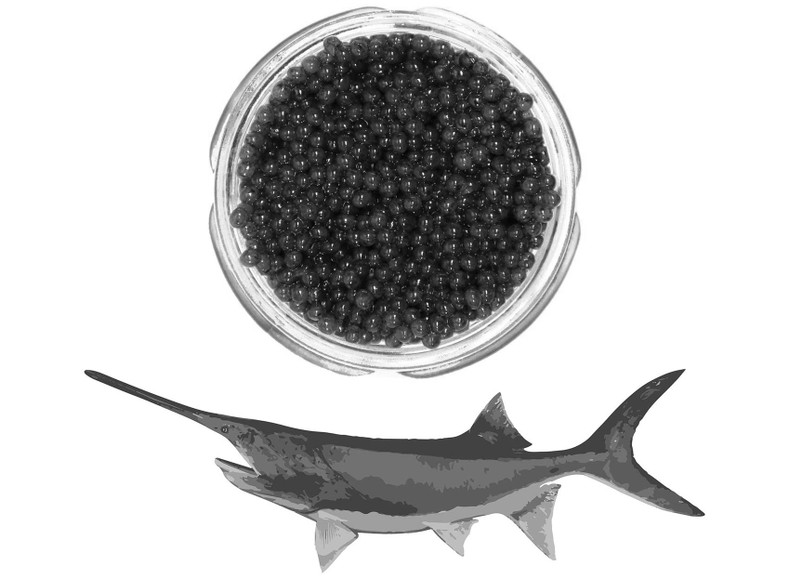American Paddlefish - Polydon Spathula - History, Characteristics and Conservation

Ancient Fish - how old are American paddlefish?
One of world's oldest filter-feeding fish species is none other than the America paddlefish. Also called Mississippi paddlefish, spoon-billed cats, or just spoonbills, Polydon spathula have been suspension-eating zooplankton in American rivers since the late Cretaceous Period. The paddlefish family has been here since way before there was the USA or even the North American continent as we know it, with paddlefish ancestor fossils dating back some 300 million years (making them 50 million years older than the first dinosaurs). Comparing records of the earliest paddlefish species to modern spoonbills here in the US, we can see just how little their natural characteristics have changed over the ages. Today, American paddlefish are considered living relics, and also a source of meat and caviar for many consumers.
Historical Range - where do paddlefish live?
Much like their physiological traits, the American Paddlefish's preferred residence has not changed much in 65 million years of existence. The Polydon spathula species reached its current evolutionary state in the primitive estuaries and rivers that surrounded the Gulf of Mexico shortly before the mass extinction of the dinosaurs. Millions of years later, these fish we able to migrate further inland thanks to the formation of the Mississippi River during the first Ice Age.
Paddlefish populations today are still found most abundantly in the Mississippi River Basin and Gulf slope drainages. 22 US states report wild paddlefish populations. They are a migratory species that can travel up to 2,000 miles in search of desirable spawning grounds. While the American paddlefish thrives in slow-flowing freshwater rivers and other riverine habitats, they have been known to frequent the brackish water environment where the Mississippi mixes with the Gulf.
 Taxonomy - how did paddlefish originate and when did they develop their extended snout?
Taxonomy - how did paddlefish originate and when did they develop their extended snout?
Paddlefish (Polyodontidae) and sturgeon (Acipenseridae) are the last surviving Acipenseriformes, an ancient fish order consisting (mostly) of species that have been extinct for millions of years. It is assumed that paddlefish and sturgeon's common ancestor diverged into the two families during the Jurassic Period (208–146 million years ago). It was around this time that their signature "paddle-nose" began to develop. When compared to the only other extant species, the Chinese paddlefish, and fossil genera from extinct paddlefish species, it is easy to see how the American Paddlefish adapted their physiological traits to life in the Mississippi. They are considered to be a highly derived species because of these novel adaptations and the array of unique characteristics they exhibit.
The species was first classified as Squalus spathula in 1772 by the taxonomist Johann Julius Walbaum, who was later established and cited as the classification authority in 1792. French naturalist Bernard Germain de Lacépède established the genus Polyodon (a Greek word meaning "many toothed") for filter feeding paddlefish after studying the vast number of combs on their gill rakes. The accidental double-categorization of the American paddlefish lead to the modern scientific name, Polydon Spathula.
Physical Traits - how big can they grow, what do they eat, and what do they use their paddles for?
American Paddlefish are among the largest freshwater fish in North America, reaching an average length of 5 ft (1.5m) and a weight of 60 lbs (27kg) at adulthood. The largest Being a primitive fish species, they have spiral valve intestines, a heart with a conus arteriosus, and a nervous system with no vertebral centrum. Similarly to sharks, their skin is scaleless and their skeleton is made almost entirely from cartilage, the one exception being their hard bony skull and rostrum sensory organ.
Having evolved in murky waters, paddlefish have naturally poor eyesight. It is the many electroreceptors in the hair cells of their rostrum and the sensory pores from the tip of their paddle to the end of their operculum flap that allow them navigate water systems and find food. Their jaw can expand to double the size of the mouth which change it into a perfect net for catching the microscopic zooplankton and insect larvae that make up their diet.
 Life Cycle - how long do paddlefish live, at what age do they reach maturity and produce eggs?
Life Cycle - how long do paddlefish live, at what age do they reach maturity and produce eggs?
American paddlefish are one of the longest living freshwater fish in North America. Despite having a high mortality rate during the first year of life, many adult paddlefish can live well into their 30's. The longest living specimens are recorder to be at least 60 years old.
Much like their sturgeon cousins, paddlefish are a slow growing and sexually late maturing species. Female American Paddlefish do not start their first maturation until they are at least 7 to 10 years old, with some individuals taking even twice as long to produce eggs. Spawning occurs in the late spring, but it is rare for a individual female to lay her eggs every year. Usually she will spawn once every two to three years, and only if the breeding grounds have ideal water flow, temperature, photoperiod, and gravel substrates for the eggs to stick to. The females deposit the unfertilized mature eggs into the rocky shallows where the males can go to fertilize them yearly. This broadcast spawning method leaves the hatchlings to fend for themselves as they are swept downstream, trying their best to survive and grow to adulthood in deeper freshwater pools.
Conservation - are paddlefish a protected species, and how many are still around today?
Paddlefish are listed as "vunerable" under the IUCN Red List of Endangered Species. Their drastic decline over the past 20 to 30 years is due almost entirely to overfishing and habitat destruction. The species became a popular catch for caviar after US and international laws were enacted to protect endangered sturgeon species. This put additional pressure on the wild paddlefish populations, as they became increasingly sought after for their eggs. Even after gaining the same protections as sturgeon, the American paddlefish still falls victim to poaching operations and under-reported catches from licensed fishermen.
The demand for paddlefish caviar is not the only cause of a decreased paddlefish population. Damming projects over recent years have blocked the water systems that many paddlefish use to reach their spawning grounds. Issues of pollution and invasive species in the Mississippi River (like zebra mussels) have put a strain on the zooplankton counts, greatly reducing the main food supply of American paddlefish in some areas.
In 2004, at the peak of their decline, Polydon spathula was listed as an at risk species. Monitoring the harvest of paddlefish by limiting the fishing seasons and catch limits protections were put in place to help the species bounce back. Exporting any product of the fish requires CITES documentation from US Fish and Wildlife. The same regulations are still in place today, and although it is difficult to get exact counts on American paddlefish populations some experts believe they have recovered well thanks to such protections.
 Paddlefish Caviar - how is it harvested, what does it taste like and how much does it cost?
Paddlefish Caviar - how is it harvested, what does it taste like and how much does it cost?
American paddlefish are commonly harvested in the wild for their meat and eggs. Being a highly regulated species, each US state decides the allowed catch limit and catch method. In some areas fishermen are allowed to use nets, but the most widespread method involves a rod and reel "snagging" technique where the fish are hooked on their bodies and reeled in to shore. The fish is killed, cleaned with purified water and cut open to remove the roe sacs, which will be screened washed and salted to make caviar.
Being so closely related to sturgeon (the fish species that produce "true caviar"), American Paddlefish roe is often considered the world's best choice for non-sturgeon malossol caviar. It is popular for its lower price point while having an appearance and flavor similar to true sturgeon caviar, making it the very best of the "caviar substitutes". Although paddlefish roe tends to be smaller in size (approx. 2 mm in diameter) and softer on the palate than true caviar, the eggs tend to have a rich botanical and nutty taste. Retail paddlefish roe prices tend to be 1/3 that of fine sturgeon caviar, making it a favorite for caviar experts and caviar beginners alike.
Sources:
https://en.wikipedia.org/wiki/Paddlefish
https://animaldiversity.org/accounts/Polyodon_spat...
https://www.fws.gov/fisheries/freshwater-fish-of-america/paddlefish.html



 (888) 268-8780
(888) 268-8780
